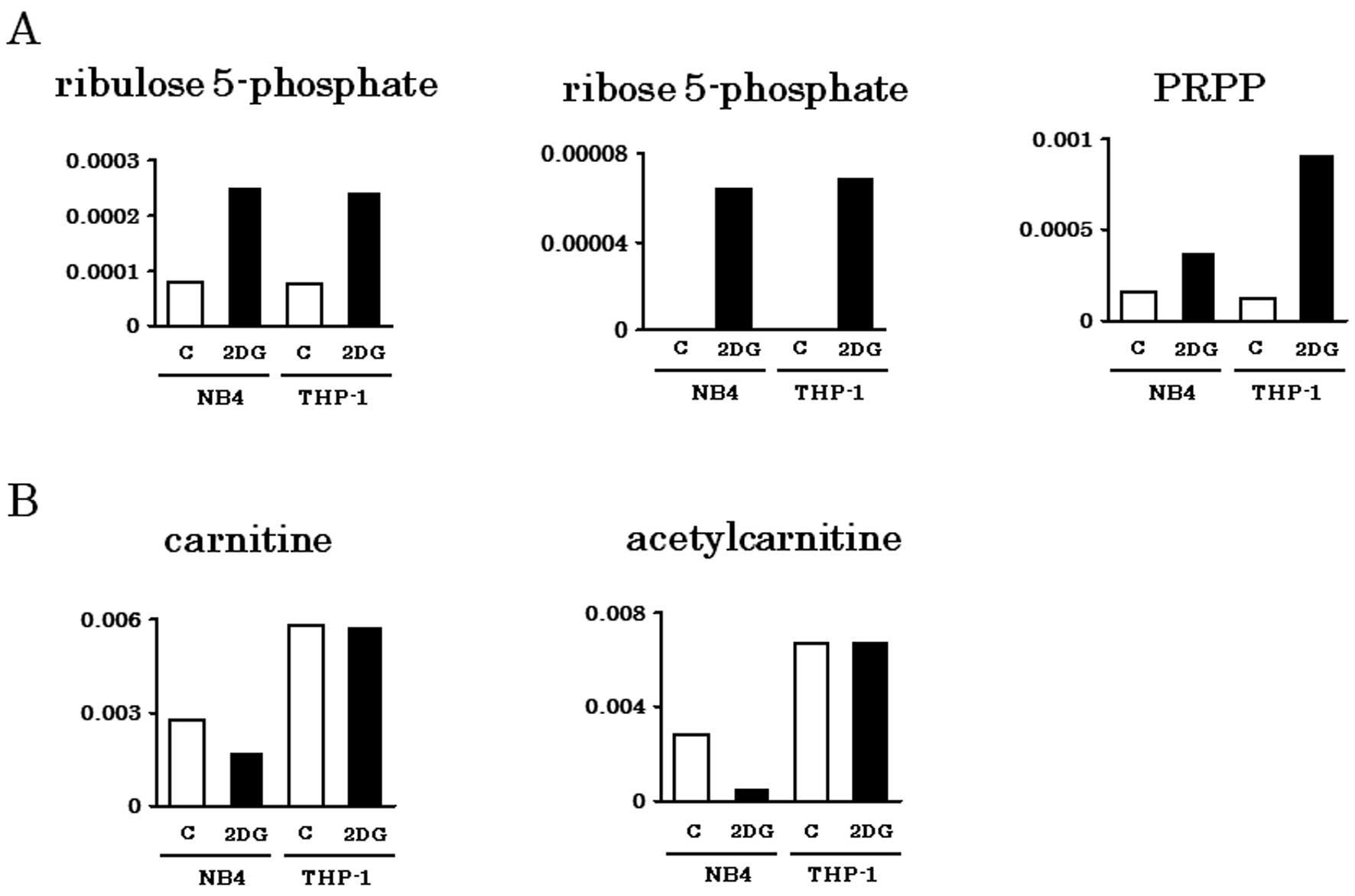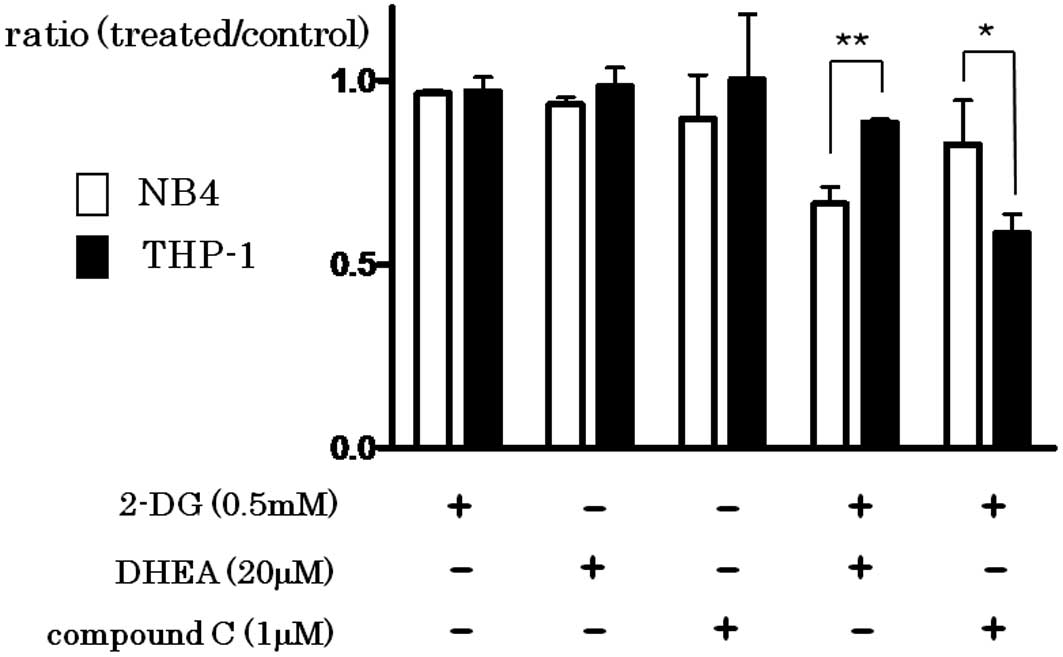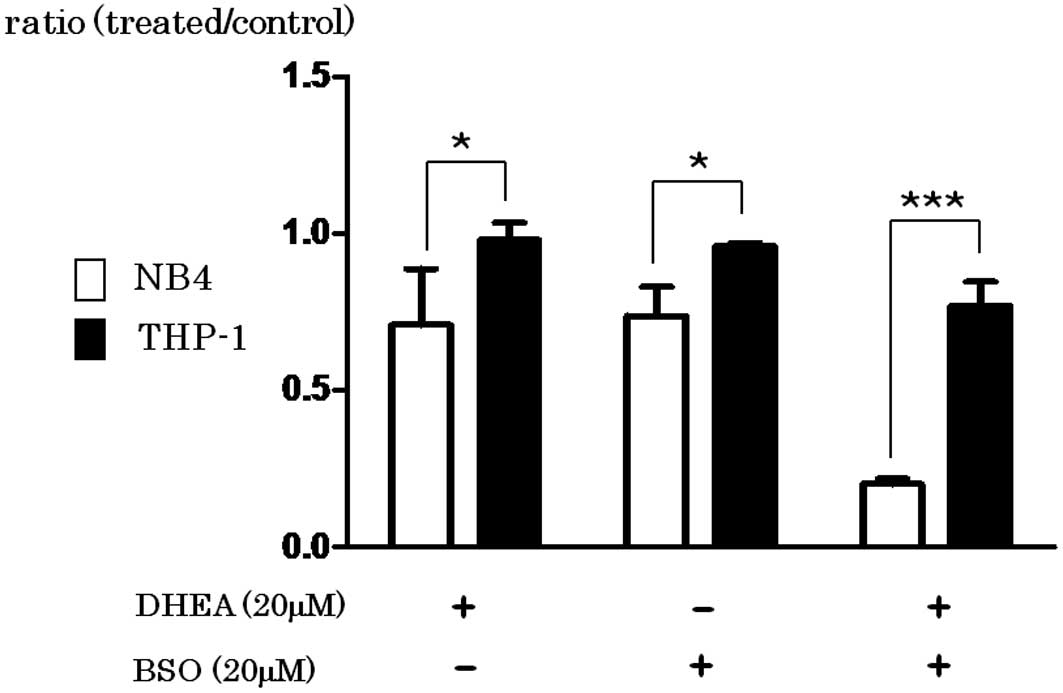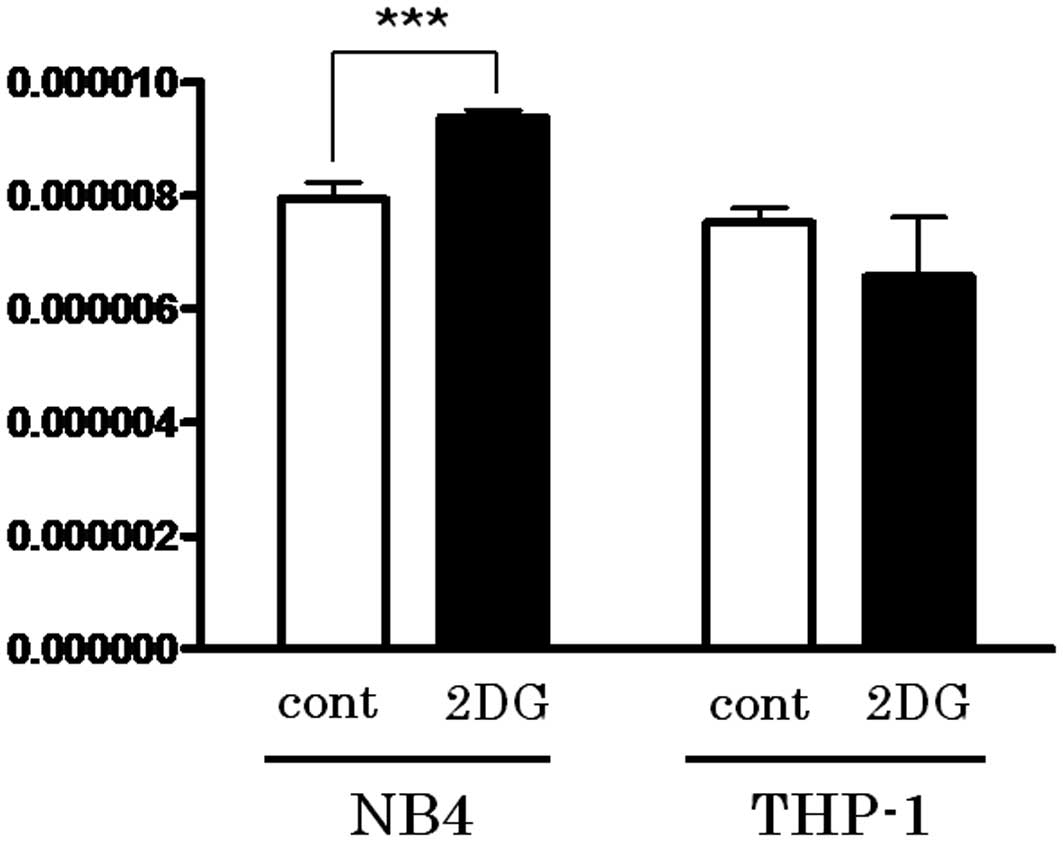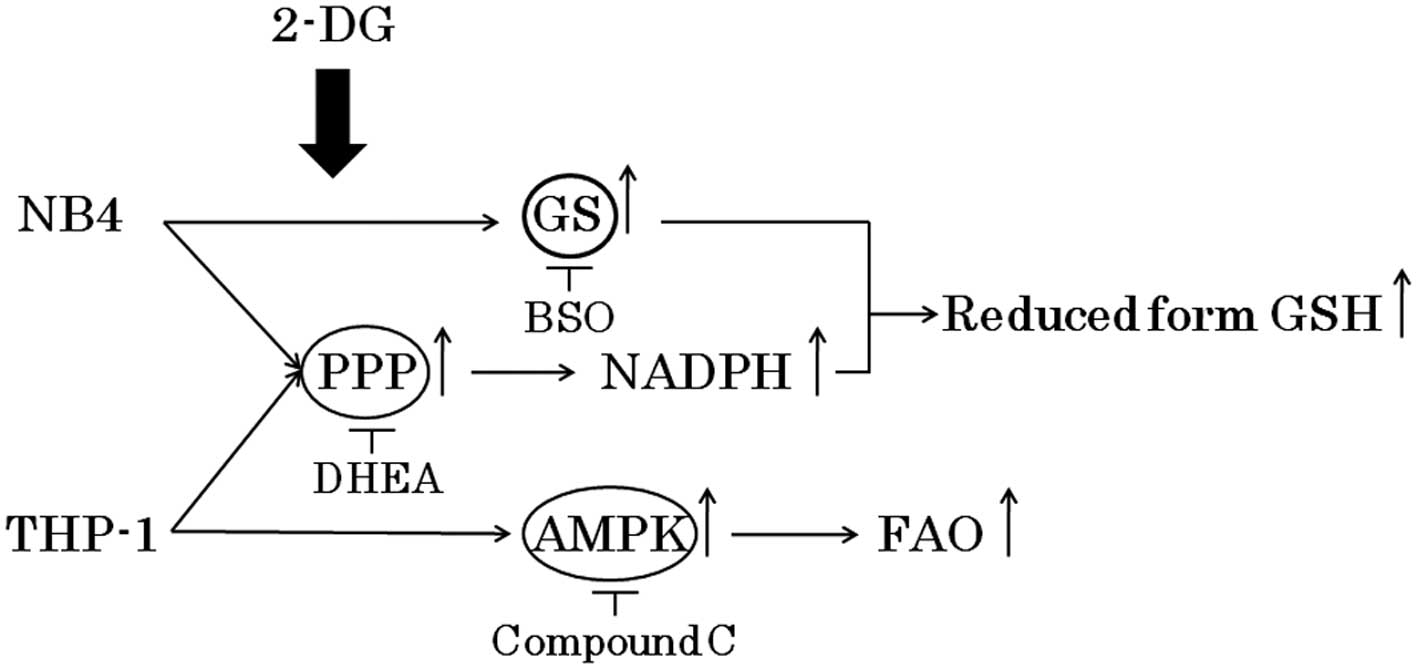Leukemia cells demonstrate a different metabolic perturbation provoked by 2-deoxyglucose
- Authors:
- Published online on: February 21, 2013 https://doi.org/10.3892/or.2013.2299
- Pages: 2053-2057
Abstract
Introduction
One of the fundamental changes that occurs in cancer cells is the shift in energy metabolism from the generation of ATP from oxidative phosphorylation to glycolysis even in the presence of sufficient oxygen (Warburg effect) (1,2). Several agents that specifically inhibit glycolytic metabolism, such as 2-deoxy-D-glucose (2-DG), have been used as effective anticancer agents in cellular systems and in animal models (3,4). Similar to glucose, 2-DG is taken up through glucose transporters (GLUTs) and is phosphorylated by hexokinase (HK) to form 2-DG-6-phosphate (2-DG-6-P). 2-DG-6-P accumulates within the cell and is not metabolized further. Then, 2-DG-6-P induces cell growth arrest and cell death by inhibiting 2 glycolytic enzymes, HK and phosphoglucose isomerase (PGI) (5,6).
Although 2-DG has been undergoing clinical trials for treatment of several types of cancers, its efficacy as a monotherapy is limited by systemic toxicity at high doses (7–9). However, 2-DG can sensitize tumors to other chemotherapeutic agents or radiotherapy (10,11).
Here, we examined the metabolic changes induced by 2-DG in leukemia cells by metabolome analysis, and aimed to identify the critical metabolic pathway which can be targeted in conjunction with glycolysis inhibition.
Materials and methods
Cell lines
Two acute myelogenous leukemia (AML) cell lines were used in this study. NB4, a t(15;17) APL cell line, was provided by Dr M. Lanotte (Saint Louis Hospital, Paris, France). THP-1, a monocytic AML monocytic cell line was obained from the Cell Resource Center for Biomedical Research (Tohoku University, Japan). Cell lines were grown in RPMI-1640 medium containing 10% fetal calf serum (FCS, Thermo Electron, Melbourne, Australia) in a humidified atmosphere of 5% CO2 and 95% air at 37°C.
Metabolome analysis
The cell lines were cultured in RPMI-1640 containing 3% FCS with or without the glycolysis inhibitor, 2-DG (0.5 mM), for 24 h. Then, 5×106 cells were centrifuged and washed in 5% mannitol. After centrifugation and removal of mannitol, cells were suspended in methanol. The samples were analyzed by capillary electrophoresis time-of-flight mass spectrometry (CE-TOFMS) (12).
Glutathione measurement
After a 24-h culture with or without 2-DG, cells were collected and assayed for glutathione (GSH) content using a GSSG/GSH quantification kit (Dojindo, Japan).
Cell cultures
Cell lines were cultured in RPMI-1640 containing 3% FCS with the glycolysis inhibitor, 2-DG (0.5 mM), the inhibitor of G6P dehydrogenase [first step of the pentose phosphate pathway (PPP)], dehydroepiandrosterone (DHEA) (20 μM), AMPK inhibitor compound C (1 μM), or in combination for 48 h. MTS [3-(4,5-dimethylthiazol-2-yl)-5-(3-carboxymethoxyphenyl)-2-(4-sulfophenyl)-2H-tetrazolium] (Promega, Madison, WI, USA) was then added to each culture. After 3 additional hours of incubation, absorbance at 490 nm was measured by an ELISA plate reader. Cell lines were also cultured in RPMI-1640 containing 3% FCS with or without DHEA (20 μM) and the GSH synthesis inhibitor, buthylsulfoximine (BSO) (20 μM) for 48 h. Then, MTS assay was also carried out.
Quantitative real-time PCR
Total RNA was isolated using the RNeasy Mini kit (Qiagen, Germany). Random hexamer priming and PrimeScript reverse transcriptase (Takara, Japan) were used to generate cDNA. Real-time reverse transcriptase polymerase chain reaction (RT-PCR) was carried out using a StepOne Plus Real-Time PCR system (Applied Biosystems, USA). Primers for PCR were as follows: glutathione synthetase forward, 5′-CCCTGCCCGAGTGGTCCAGT-3′; reverse, 5′-CACTCCCGCTGCCACACCAC-3′ and 18S rRNA (as a control gene) forward, 5′-CGGCGACGACCCATTCGAAC-3′; reverse, 5′-GAATCGAACCCTGATTCCCCGTC-3′. The relative gene expression level was determined by comparison with 18S rRNA.
Statistical analysis
Statistical analysis was carried out by the t-test to examine the difference in growth of the cell lines, GSH content or glutathione synthetase mRNA expression.
Results
Metabolome analysis of the leukemia cell lines
Metabolites in the glycolytic pathway (pyruvic acid and lactic acid) were abundantly detected in the NB4 cells. However, these were greatly decreased by 2-DG treatment (Fig. 1). Metabolites of the tricarboxylic acid (TCA) cycle were comparably detected in both cell lines. The amounts of TCA cycle metabolites in the THP-1 cells were not obviously influenced by 2-DG as in the NB4 cells. This finding indicates that TCA cycle metabolites in the THP-1 cells were derived from non-glucose materials such as amino acids or fatty acids. Metabolites of PPP (Ru5P, R5P, PRPP) were abundantly detected in both NB4 and THP-1 cells, particularly when treated with 2-DG (Fig. 2A). Carnitine and its acetylated form, acetylcarnitine are important for incorporation of fatty acids into mitochondria. Consistent with our previous observation that THP-1 depends on fatty acid oxidation for energy production (13), carnitine and acetylcarnitine were abundantly detected in THP-1 cells even with 2-DG treatment (Fig. 2B).
Synergistic effect of the inhibition of glycolysis and PPP or AMPK
The addition of 2-DG (0.5 mM), DHEA (20 μM) or compound C (1 μM) did not effectively inhibit the growth of both cell lines. However, simultaneous addition of 2-DG and DHEA synergistically inhibited the growth, particularly in the NB4 cells (P=0.0011), while simultaneous addition of 2-DG and compound C inhibited the growth of THP-1 cells more effectively than that of NB4 cells (P=0.0319) (Fig. 3).
Activation of PPP by 2-DG treatment leads to reduction in GSH
The first step of PPP is triggered by G6P dehydrogenase, which produces NADPH. Since NADPH is utilized for GSH reduction, the content of the reduced form of GSH in the cell lines treated with or without 2-DG was determined. As shown in Fig. 4, the reduced form of GSH was upregulated following 2-DG treatment only in the NB4 cells (P=0.0494).
BSO inhibits the synthesis of GSH
DHEA inhibits G6P dehydrogenase, resulting in decreased NADPH and the reduced form of GSH. As shown in Fig. 5, the growth of NB4 cells was greatly inhibited by the addition of BSO (P=0.033), DHEA (P=0.0254) or in combination (P=0.0001) when compared with the effect in THP-1 cells.
Expression of glutathione synthetase is upregulated by 2-DG in NB4 cells
Glutathione synthetase (GS) catalyzes the condensation of γ-glutamylcysteine and glycine to form glutathione. As shown in Fig. 6, real-time quantitative RT-PCR study revealed that expression of GS was upregulated following 2-DG treatment in NB4 cells (P=0.0007). This may explain the finding that the reduced form of GSH was upregulated by 2-DG in NB4 cells and that the growth of NB4 cells was more effectively inhibited by BSO.
Discussion
Metabolome analysis revealed that NB4 cells mainly utilized glucose as an energy source by glycolysis and oxidative phosphorylation in mitochondria, as metabolites in the glycolytic pathway and in the TCA cycle were significantly decreased by 2-DG, a glycolysis inhibitor. In THP-1 cells, metabolites in the TCA cycle were not decreased to the same extent by 2-DG as in the NB4 cells, which indicates that THP-1 cells utilized an energy source other than glucose. TCA cycle metabolites in THP-1 cells may be derived from acetyl-CoA by fatty acid β-oxidation, which was supported by abundant detection of carnitine and acetylcarnitine in the THP-1 cells (Fig. 2B). Our previous observation (13) that THP-1 depends on fatty acid oxidation for energy production also corroborates of this finding. 2-DG treatment increased the PPP metabolites in both cell lines. After entering the cell, 2-DG is phosphorylated by hexokinase to form 2-DG-6-phosphate, which cannot be further metabolized, and its accumulation leads to inhibition of the glycolytic pathway and shunting through the PPP (5,14,15). This PPP flux augments the generation of NADPH by glucose-6-phosphate dehydrogenase (G-6-PDH). One of the uses of NADPH is to prevent oxidative stress by reducing glutathione (from GSSG to GSH). As shown in Fig. 4, an increase in the reduced form of GSH following 2-DG treatment was noted only in the NB4 cells. Upregulation of GS expression may explain the increase in the reduced form of GSH by 2-DG in the NB4 cells. We demonstrated that the combination of 2-DG and inhibition of PPP by DHEA effectively suppressed the growth of NB4 cells.
It has been reported that AMPK inhibits fatty acid synthesis and activates fatty acid oxidation (16,17). We previously demonstrated that 2-DG treatment activates AMPK in THP-1 cells (13), which may explain the replenishment of the TCA cycle by fatty acid oxidation by carnitine palmitoyltransferase. Then, the combination of 2-DG and inhibition of AMPK by compound C potently suppressed the growth of THP-1 (Fig. 3).
Although 2-DG has been effective in preclinical and clinical studies, this treatment has not been fully explored due to concerns related to potential toxicities such as brain toxicity at high doses (8,9). It is important to determine the appropriate combination of metabolic inhibitors at low concentrations which do not cause toxicities. Here, we demonstrated that the combination of 2-DG and DHEA or compound C at a relatively low concentration effectively inhibited the growth of NB4 and THP-1 cells, respectively (Fig. 7). Further studies are warranted to ascertain the efficacy and safety of these combinations.
Acknowledgements
We are grateful to Dr N. Kamada (Hiroshima University, Japan) for Kasumi-1 and to Dr M. Lanotte (Saint Louis Hospital, Paris, France) for the NB-4 cell line. We also thank Ms. A. Usui and A. Nakamura for their technical and secretarial assistance. This study was supported in part by the Ministry of Education, Culture, Sports, Science and Technology, Japan (MEXT)-Supported Program for the Strategic Research Foundation at Private Universities, 2011–2015 (S1101027).
References
|
Warburg O: On the origin of cancer cells. Science. 123:309–314. 1956. View Article : Google Scholar : PubMed/NCBI | |
|
Gatenby RA and Gillies RJ: Why do cancers have high aerobic glycolysis? Nat Rev Cancer. 4:891–899. 2004. View Article : Google Scholar : PubMed/NCBI | |
|
Pelicano H, Martin DS, Xu RH and Huang P: Glycolysis inhibition for anticancer treatment. Oncogene. 25:4633–4646. 2006. View Article : Google Scholar : PubMed/NCBI | |
|
El Mjiyad N, Caro-Maldonado A, Ramírez-Peinado S and Muñoz-Pinedo C: Sugar-free approaches to cancer cell killing. Oncogene. 30:253–264. 2011.PubMed/NCBI | |
|
Sols A and Crane RK: Substrate specificity of brain hexokinase. J Biol Chem. 210:581–595. 1954.PubMed/NCBI | |
|
Kurtoglu M, Gao N, Shang J, Maher JC, Lehrman MA, Wangpaichitr M, Savaraj N, Lane AN and Lampidis TJ: Under normoxia, 2-deoxy-D-glucose elicits cell death in select tumor types not by inhibition of glycolysis but by interfering with N-linked glycosylation. Mol Cancer Ther. 6:3049–3058. 2007. View Article : Google Scholar : PubMed/NCBI | |
|
Tennant DA, Durán RV and Gottlieb E: Targeting metabolic transformation for cancer therapy. Nat Rev Cancer. 10:267–277. 2010. View Article : Google Scholar : PubMed/NCBI | |
|
Porporato PE, Dhup S, Dadhich RK, Copetti T and Sonveaux P: Anticancer targets in the glycolytic metabolism of tumors: a comprehensive review. Front Pharmacol. 2:492011. View Article : Google Scholar : PubMed/NCBI | |
|
Cheong H, Lu C, Lindsten T and Thompson CB: Therapeutic targets in cancer cell metabolism and autophagy. Nat Biotechnol. 30:671–678. 2012. View Article : Google Scholar : PubMed/NCBI | |
|
Maschek G, Savaraj N, Priebe W, Braunschweiger P, Hamilton K, Tidmarsh GF, De Young LR and Lampidis TJ: 2-Deoxy-D-glucose increases the efficacy of adriamycin and paclitaxel in human osteosarcoma and non-small cell lung cancers in vivo. Cancer Res. 64:31–34. 2004. View Article : Google Scholar : PubMed/NCBI | |
|
Singh D, Banerji AK, Dwarakanath BS, Tripathi RP, Gupta JP, Mathew TL, Ravindranath T and Jain V: Optimizing cancer radiotherapy with 2-deoxy-d-glucose dose escalation studies in patients with glioblastoma multiforme. Strahlenther Onkol. 181:507–514. 2005. View Article : Google Scholar : PubMed/NCBI | |
|
Ooga T, Sato H, Nagashima A, Sasaki K, Tomita M, Soga T and Ohashi Y: Metabolomic anatomy of an animal model revealing homeostatic imbalances in dyslipidaemia. Mol Biosyst. 7:1217–1223. 2011. View Article : Google Scholar : PubMed/NCBI | |
|
Suganuma K, Miwa H, Imai N, Shikami M, Gotou M, Goto M, Mizuno S, Takahashi M, Yamamoto H, Hiramatsu A, Wakabayashi M, Watarai M, Hanamura I, Imamura A, Mihara H and Nitta M: Energy metabolism of leukemia cells: glycolysis versus oxidative phosphorylation. Leuk Lymphoma. 51:2112–2119. 2010. View Article : Google Scholar : PubMed/NCBI | |
|
Chen W and Guéron M: The inhibition of bovine heart hexokinase by 2-deoxy-D-glucose-6-phosphate: characterization by 31P NMR and metabolic implications. Biochimie. 74:867–873. 1992. View Article : Google Scholar : PubMed/NCBI | |
|
Sandulache VC, Ow TJ, Pickering CR, Frederick MJ, Zhou G, Fokt I, Davis-Malesevich M, Priebe W and Myers JN: Glucose, not glutamine, is the dominant energy source required for proliferation and survival of head and neck squamous carcinoma cells. Cancer. 117:2926–2938. 2011.PubMed/NCBI | |
|
Hardie DG and Pan DA: Regulation of fatty acid synthesis and oxidation by the AMP-activated protein kinase. Biochem Soc Trans. 30:1064–1070. 2002. View Article : Google Scholar : PubMed/NCBI | |
|
Jeon SM, Chandel NS and Hay N: AMPK regulates NADPH homeostasis to promote tumour cell survival during energy stress. Nature. 485:661–665. 2012. View Article : Google Scholar : PubMed/NCBI |




